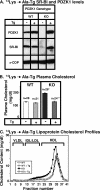In vitro and in vivo analysis of the binding of the C terminus of the HDL receptor scavenger receptor class B, type I (SR-BI), to the PDZ1 domain of its adaptor protein PDZK1
- PMID: 20739281
- PMCID: PMC2966114
- DOI: 10.1074/jbc.M110.164418
In vitro and in vivo analysis of the binding of the C terminus of the HDL receptor scavenger receptor class B, type I (SR-BI), to the PDZ1 domain of its adaptor protein PDZK1
Abstract
The PDZ1 domain of the four PDZ domain-containing protein PDZK1 has been reported to bind the C terminus of the HDL receptor scavenger receptor class B, type I (SR-BI), and to control hepatic SR-BI expression and function. We generated wild-type (WT) and mutant murine PDZ1 domains, the mutants bearing single amino acid substitutions in their carboxylate binding loop (Lys(14)-Xaa(4)-Asn(19)-Tyr-Gly-Phe-Phe-Leu(24)), and measured their binding affinity for a 7-residue peptide corresponding to the C terminus of SR-BI ((503)VLQEAKL(509)). The Y20A and G21Y substitutions abrogated all binding activity. Surprisingly, binding affinities (K(d)) of the K14A and F22A mutants were 3.2 and 4.0 μM, respectively, similar to 2.6 μM measured for the WT PDZ1. To understand these findings, we determined the high resolution structure of WT PDZ1 bound to a 5-residue sequence from the C-terminal SR-BI ((505)QEAKL(509)) using x-ray crystallography. In addition, we incorporated the K14A and Y20A substitutions into full-length PDZK1 liver-specific transgenes and expressed them in WT and PDZK1 knock-out mice. In WT mice, the transgenes did not alter endogenous hepatic SR-BI protein expression (intracellular distribution or amount) or lipoprotein metabolism (total plasma cholesterol, lipoprotein size distribution). In PDZK1 knock-out mice, as expected, the K14A mutant behaved like wild-type PDZK1 and completely corrected their hepatic SR-BI and plasma lipoprotein abnormalities. Unexpectedly, the 10-20-fold overexpressed Y20A mutant also substantially, but not completely, corrected these abnormalities. The results suggest that there may be an additional site(s) within PDZK1 that bind(s) SR-BI and mediate(s) productive SR-BI-PDZK1 interaction previously attributed exclusively to the canonical binding of the C-terminal SR-BI to PDZ1.
Figures








Similar articles
-
Identification of the PDZ3 domain of the adaptor protein PDZK1 as a second, physiologically functional binding site for the C terminus of the high density lipoprotein receptor scavenger receptor class B type I.J Biol Chem. 2011 Jul 15;286(28):25171-86. doi: 10.1074/jbc.M111.242362. Epub 2011 May 23. J Biol Chem. 2011. PMID: 21602281 Free PMC article.
-
Overexpression of the PDZ1 domain of PDZK1 blocks the activity of hepatic scavenger receptor, class B, type I by altering its abundance and cellular localization.J Biol Chem. 2008 Aug 8;283(32):22097-104. doi: 10.1074/jbc.M800029200. Epub 2008 Jun 10. J Biol Chem. 2008. PMID: 18544532 Free PMC article.
-
Noncanonical role of the PDZ4 domain of the adaptor protein PDZK1 in the regulation of the hepatic high density lipoprotein receptor scavenger receptor class B, type I (SR-BI).J Biol Chem. 2013 Jul 5;288(27):19845-60. doi: 10.1074/jbc.M113.460170. Epub 2013 May 17. J Biol Chem. 2013. PMID: 23720744 Free PMC article.
-
Regulation of SR-BI-mediated high-density lipoprotein metabolism by the tissue-specific adaptor protein PDZK1.Curr Opin Lipidol. 2005 Apr;16(2):147-52. doi: 10.1097/01.mol.0000162319.54795.e5. Curr Opin Lipidol. 2005. PMID: 15767854 Review.
-
Role of the adaptor protein PDZK1 in controlling the HDL receptor SR-BI.Curr Opin Lipidol. 2009 Jun;20(3):236-41. doi: 10.1097/MOL.0b013e32832aee82. Curr Opin Lipidol. 2009. PMID: 19421056 Free PMC article. Review.
Cited by
-
Identification of the PDZ3 domain of the adaptor protein PDZK1 as a second, physiologically functional binding site for the C terminus of the high density lipoprotein receptor scavenger receptor class B type I.J Biol Chem. 2011 Jul 15;286(28):25171-86. doi: 10.1074/jbc.M111.242362. Epub 2011 May 23. J Biol Chem. 2011. PMID: 21602281 Free PMC article.
-
D-AKAP2:PKA RII:PDZK1 ternary complex structure: insights from the nucleation of a polyvalent scaffold.Protein Sci. 2015 Jan;24(1):105-16. doi: 10.1002/pro.2593. Epub 2014 Dec 5. Protein Sci. 2015. PMID: 25348485 Free PMC article.
-
SR-BI: Linking Cholesterol and Lipoprotein Metabolism with Breast and Prostate Cancer.Front Pharmacol. 2016 Oct 7;7:338. doi: 10.3389/fphar.2016.00338. eCollection 2016. Front Pharmacol. 2016. PMID: 27774064 Free PMC article. Review.
-
Regulation of G protein-coupled receptor function by Na+/H+ exchange regulatory factors.Pharmacol Rev. 2011 Dec;63(4):882-900. doi: 10.1124/pr.110.004176. Epub 2011 Aug 26. Pharmacol Rev. 2011. PMID: 21873413 Free PMC article. Review.
-
Challenges in using cultured primary rodent hepatocytes or cell lines to study hepatic HDL receptor SR-BI regulation by its cytoplasmic adaptor PDZK1.PLoS One. 2013 Jul 23;8(7):e69725. doi: 10.1371/journal.pone.0069725. Print 2013. PLoS One. 2013. PMID: 23936087 Free PMC article.
References
-
- van Ham M., Hendriks W. (2003) Mol. Biol. Rep. 30, 69–82 - PubMed
-
- Doyle D. A., Lee A., Lewis J., Kim E., Sheng M., MacKinnon R. (1996) Cell 85, 1067–1076 - PubMed
-
- Pawson T., Scott J. D. (1997) Science 278, 2075–2080 - PubMed
-
- Kocher O., Comella N., Tognazzi K., Brown L. F. (1998) Lab. Invest. 78, 117–125 - PubMed
Publication types
MeSH terms
Substances
Associated data
- Actions
Grants and funding
LinkOut - more resources
Full Text Sources
Molecular Biology Databases
Research Materials

